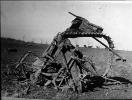IMO a path being fairly straight isn't necessarily reliable, families can be straight - Fujita even had a term, 'series mode' for them. Secondly it depends on how the tracks were plotted and we usually have little detail. The Storm Data entry for the Wilson tornado makes it sound like the path was not obvious and that they tried hard to make it join up. I don't have Grazulis' full entry on hand but the statement on Wiki that it was inexperienced surveyors tallies. The path in the NOAA is report is made of long segments and has enough changes in direction you could fit a family. The Ellettsville IN tornado was even more recent yet from its description and satellite imagery it was a family. There's no good imagery for the Wilson tornado and I could't find it on aerial imagery from March 1993. Given the history of spuriously long tracks, I'd want more evidence, and I say we won't know unless someone does a detailed study.
The Lawrence and Albion tornadoes from 1990 are two events whose courses are fairly straight with no major deviations, yet both are pretty much confirmed families by their descriptions - they
are two events that I would like to see broken down by detailed research.
I'd add that we don't have the notes of surveys (I suppose they could still exist somewhere). We don't have Grazulis' working, nor do we often have the working of the various amateurs (whether here or on other websites) who try reconstructing past events. We can sometimes independently check (for example we can look at the aerials Tornado Talk used for the 1971 outbreak) but not always, at least without a lot of effort. Different people interpret data differently, so one researcher may come to a different conclusion to another about a given event.
(Moving on)
With the Jasper tornado, the path is easily visible on satellite (though not nearly as intense as Guin) from around the Sipsey River to Jasper. The earlier part isn't visible and the later part might have some faint suggestions that could be imagined. The storm data description says it was 'almost continuous' before Jasper and 'skipping' after, Fujita's map based on aerial survey lends an argument to its continuity. I wouldn't put it on the certain pile without further study.
For Yazoo City, south of French Camp, there appears to be another break. The path becomes indistinct around the Natchez Trace Parkway. Then a new one appears displaced to the north. This would make the Yazoo City tornado's path 83-84 miles long.
View attachment 43305 View attachment 43306
Near Durant there's something a bit harder to interpret. The path narrows and swings on a curved course around the town. It appears to possibly end, then resumes from a clear area on the heading that it had before (unfortunately it goes from a cleared area). This could be another path break, a failed occlusion or even a merger. If it is a break, then it makes the Yazoo City path 56-57 miles long.
View attachment 43307 View attachment 43308








































